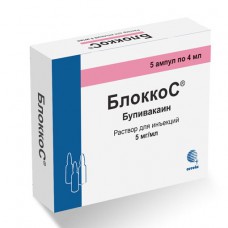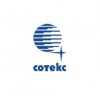Expiration date: 03/2026
In may 2011 the Russian pharmaceutical market, new drug BloccoC production company Sotex. Bupivacaine, the active ingredient of the drug BloccoC, included in the List of strategically important drugs, production of which must be established on the territory of the Russian Federation for the treatment of most common diseases. Just a list of 57 international nonproprietary names of drugs.
The BloccoC is a long-acting anesthetic and is available in the form of solution for injection 5 mg/ml 4 ml ? 5 and ?10.
Drug used in various types of local anesthesia: analgesia in trauma, surgical interventions, including cesarean section, labor pain relief, conducting painful diagnostic procedures, such as arthroscopy.
The release of the drug BloccoC is a sequential implementation of import substitution program in the field of production of socially significant medicinal drugs, allowing to increase the share of domestic drugs on the Russian pharmaceutical market, to provide patients with quality and affordable medicines and to improve the efficiency of budget programs by reducing the cost of treatment and provide therapy to a large number of patients.
Pharmacological action:
Anesthetic is long-acting amide type, 4 times more powerful than lidocaine. Reversibly blocks impulse conduction along the nerve fiber due to effects on sodium channels, has a hypotensive effect, slows the heart rate. When intercostales blockade postoperative analgesia is maintained for 7-14 h After a single epidural injection at a concentration of 5 mg/ml, the duration of effect is 2-5 h, until 12 h, when the peripheral nerve block. The solution of the drug containing dextrose, a hyperbaric and spreading into the subarachnoid space is affected by gravity. A small volume of distribution in the subarachnoid space leads to a lower average concentration and a reduction in the duration of effect of the drug compared with Isobaric solution. Use solutions at a concentration of 2.5 mg/ml has less effect on motor nerves.
Indications:
Different types of local anesthesia (anesthesia for trauma surgery, including cesarean section, labor pain relief, a painful diagnostic procedures, for example arthroscopy): local infiltration analgesia (including dentistry), local anesthesia (including in dentistry, intercostal blockade, cervical vagosimpaticescoy, blockade of large and small nerves), caudal or lumbar epidural blockade, spinal (subarachnoid) anaesthesia retrobulbar (regional) anesthesia.
Contraindications:
Hypersensitivity (including to other amide local anesthetic drugs). Not used when/V regional anaesthesia (blockage on Bira) (accidental penetration bupivacaine in blood stream can cause acute systemic toxic reactions), do not apply for the holding of paracervical blockade for anesthesia during childbirth (can cause fetal death), children up to age 5 years. General contraindications for epidural anesthesia: acute Central nervous system disease, severe hypotension (cardiogenic or hypovolemic shock), pustular skin lesions at the place of intended puncture. General contraindications to intrathecal anesthesia: acute diseases of the CNS such as meningitis, poliomyelitis, intracranial hemorrhage, and tumors of the Central nervous system, narrowing of the spinal canal and spinal disorders in the acute phase (spondylitis, tumour) or recent trauma (fractures) of the spine, sepsis, pernicious anemia with subacute combined degeneration of the spinal cord, pustular skin lesions at the place of intended puncture or bordering the puncture site, severe hypotension (cardiogenic or hypovolemic shock), the bleeding disorders or concomitant therapy with anticoagulants.
Side effects:
In the Central and peripheral nervous system: post dural puncture headache, dizziness, drowsiness, seizures (risk of their development on the background of increased hypercapnia and acidosis), tremor, diplopia, noise and ringing in the ears, paraplegia, paresis, disesthesias, neuropathy, arachnoiditis, cauda equina syndrome (paralysis of lower extremities, paresthesia), respiratory depression, accidental total spinal block, numbness of the tongue, involuntary urination, involuntary defecation, urinary retention. By SSS: reducing AD, ventricular arrhythmia, bradycardia, blockade, cardiac arrest. From the digestive system: nausea, vomiting. Allergic reactions: skin itching, skin rash, etc. anaphylactic reactions (mostly anaphylactic shock), urticaria (skin and mucous membranes). Other: muscle weakness, pain in the lumbar region.
Method of application and dose:
The concentration of solution used depends on the type of anesthesia: infiltration - 0.25-0.5% and - 0.25-0.5%, retrobulbar - 0.75%, vagosimpaticescoy blockade - 0.25%, lumbar epidural anesthesia is 0.1-0.75%, caudal - 0.25-0.5%. When performing lumbar epidural anaesthesia: to receive only the sensing unit using 20-40 ml of 0.25% solution, repeat the injection every 3 h for partial motor block injected 10-20 ml of 0.5% solution repeat the injection every 3 h for complete motor block - 10-20 ml of 0.75% solution. In children with body weight more than 10 kg single dose for the conduct of epidural anesthesia is 1-2.5 mg/kg of 0.125-0.25% solution. To maintain epidural anesthesia is used, the introduction of 0.2-0.4 mg/kg/h in a 0.15%, 0.125-0.25% solution. The maximum dose is 0.4 mg/kg/h For conducting a lumbar anesthesia in obstetrics a continuous infusion of 1-3 ml/h 0.625% or 5-15 ml/h 0.125% solutions. When performing caudal anesthesia is used 15-30 ml of 0.25% solution of bupivacaine for partial motor block with repeat injection every 3 h 15-30 ml of 0.5% solution - for complete motor block with repeat injection every 3 h For carrying out caudal anesthesia in children weighing more than 10 kg single dose 1-2.5 mg/kg of 0.125-0.25% solution. To maintain caudal anesthesia using the introduction of 0.2-0.4 mg/kg/h in a 0.1%, 0.125-0.25% solution. With repeated administration the maximum dose is 0.4 mg/kg/h. For carrying out caudal anesthesia in children weighing up to 10 kg are administered 1-1.25 mg/kg of 0.125-0.25% solution. To maintain caudal anesthesia - 0.1-0.2 mg/kg/h in a 0.1%, 0.125-0.25% solution. The maximum dose is 0.2 mg/kg/h. To conduct local infiltration anesthesia applied a single dose of 70 ml of 0.25% solution. In children, 0.5-2.5 mg/kg 0.25-0.5% solution. For complete motor block when performing regional anesthesia in adult patients using 5-70 ml 0.25% solution or 5-35 ml of 0.5% solution. The introduction of these doses may be repeated every 3 h in children for regional anesthesia used doses of 0.3-2.5 mg/kg of 0.25-0.5% solution. To conduct retrobulbar (regional) block is used 2-4 ml of 0.75% solution. To initiate vagosimpaticescoy unit use 20 to 50 ml of 0.25% solution, repeat the injection every 3 h For a spinal anesthesia is used 0.5% Isobaric solution (based on 0.9% NaCl solution) and 0.5% hyperbaric solution (based on an 8% dextrose solution). The maximum doses for adults are: single - 150 mg daily to 400 mg. The maximum dose for children using bupivacaine for local or regional anesthesia: single - 1 ml/kg of 0.25% solution, when using a 0.5% solution of bupivacaine - 0.5 ml/kg.
Special instructions:
When conducting epidural anesthesia, it is necessary to conduct a test dose of 3-5 ml. During the test dose within 5 min is necessary to maintain verbal contact with the patient and regularly to determine heart rate. Aspiration should be carried out before the introduction of the main dose, which should be introduced slowly, under constant supervision. When a minimum of toxic effects, further introduction is stopped. In the practice of spinal anaesthesia bupivacaine is a drug with minimal local toxicity. The drug is more cardiotoksicnae than. local anesthetic drugs (possible AV blockade, ventricular arrhythmias, including ventricular fibrillation and cardiac arrest), and so users must repeatedly perform the aspiration test. Paracervical blockade can largely affect the fetus than. blockade. 0.75% solution is not used in obstetric practice because of the frequent development of cardiac and respiratory patients. The introduction of small doses of local anesthetics in the head, neck, and also in the retrobulbar space or area zvezchatye ganglion may give a negative reaction, similar to systemic toxicity (including respiratory failure), in this connection, you need to have ready the necessary drugs and equipment. The effectiveness of adding a vasoconstrictor proven only for low-concentrated solutions (0.125-0.25%). Such solutions while achieving analgesia preserve motor function and may be recommended for regional analgesia in the postoperative period and in obstetric practice. Patients required control functions of the cardiovascular system, respiratory system and Central nervous system. You must cancel the MAO inhibitors 10 days before the introduction of the local anesthetic. During the period of treatment must be careful when driving and occupation of other potentially hazardous activities, require high concentration and psychomotor speed reactions.
Interaction:
Use with MAO inhibitors (furazolidone, procarbazine, selegiline) increases the risk of excessive loss AD. Vasoconstrictors (epinephrine, methoxamine, phenylephrine) prolong local anesthetic effect low concentration (0.125-0.25%) solutions of bupivacaine. Local anesthetics increase CNS depression caused by drugs depressing the Central nervous system. Anticoagulants (ardeparin sodium, dalteparin sodium, danaparoid sodium, enoxaparin sodium, heparin, warfarin) increase the risk of bleeding. When processing the injection of local anesthetic with disinfectant solutions containing heavy metals, increases the risk of local reactions in the form of pain and swelling. When using local anaesthetic drugs for spinal and epidural anesthesia with guanadrel, guanetidina, mecamylamine, trimetafan camsylate increases the risk of pronounced blood pressure reduction and bradycardia. The combination of General inhalation anesthesia with halothane increases the risk of developing cardiotoxicity of bupivacaine. Strengthens and lengthens the effect of muscle relaxant drugs. With narcotic analgesics develops additive effect that is used when conducting epidural anesthesia, but enhanced respiratory depression. Shows antagonism antimiasteniceskih PM by action on skeletal muscles, especially when used in high doses, which requires additional correction treatment of myasthenia gravis. Cholinesterase inhibitors (antimiasteniceskih drugs, cyclophosphamide, gamecare bromide, echothiophate chloride, thiotepa) reduces metabolism of local anaesthetic drugs.


